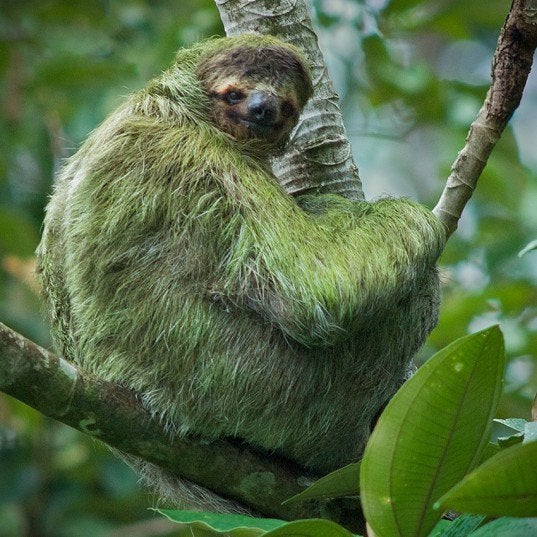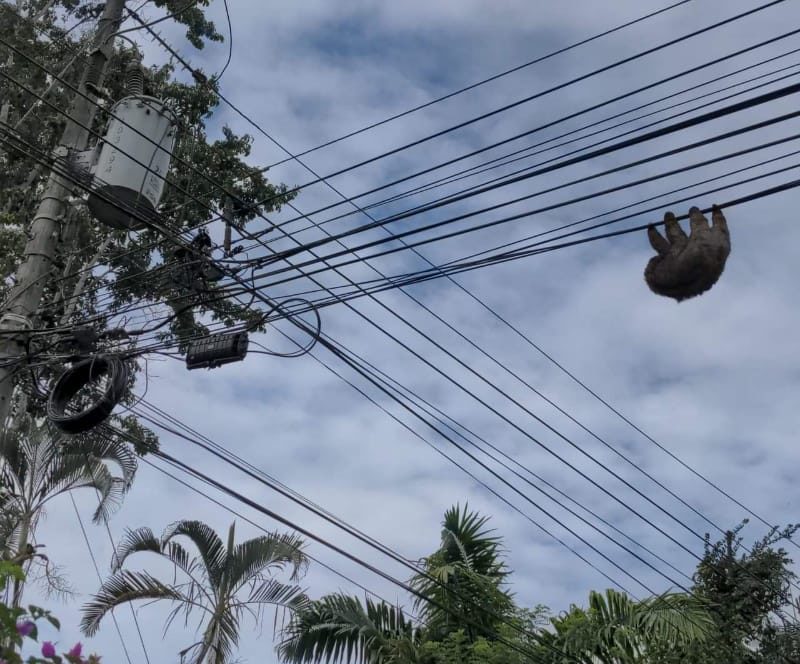Sloth fur fungi could cure cancer

Recent studies have shown that some of the fungi found on sloths could combat MRSA, Chagas disease, malaria and breast cancer.
The wonderful world of sloth fur
They may seem cute, but you might think twice about cuddling one when you realise sloths have a whole ecosystem of symbiotic organisms living in their fur. From moths, beetles, worms, caterpillars, cockroaches to algae and fungi, sloths may not be moving, but they are crawling with life.
Three-toed sloths have been recorded as having as many as 120 moths living in their fur. This is a unique and beneficial relationship as those with more moths have a higher nitrogen content in their fur and so have more algae. Sloth hairs contain microscopic grooves which encourage the growth of algae. Algae is beneficial to sloths, as it helps camouflage them from predators, disguises their smell and leeches nutrients into the sloth’s skin (free food and they don’t even have to go anywhere!).

Sloths poo once a week, but why do they climb down to do it?
It’s a mystery as to why they climb down to the bottom of the tree to poo. Climbing down expends vast amounts of energy (8% of their total energy) and exposes them to predators like jaguars, harpy eagles and humans. There are two theories as to why they do this. One is that the poo sends important scent signals to other nearby sloths, for example it could tell a male sloth when a female sloth is ovulating.
When sloths poo they can lose a third of their body weight.
https://slothconservation.org/why-do-sloths-poop-on-the-ground/
Another theory is that they do it for the moths. When sloths poo, their moths lay eggs in it. The new moths then fly back up to the sloths. Scientists at the Royal Society Biological Unit think that this relationship with the moths might be so valuable to the sloth that it is worth risking their lives.
Moths are portals for nutrients, increasing nitrogen levels in sloth fur, which fuels algal growth. Sloths consume these algae-gardens, presumably to augment their limited diet.
But what’s this got to do with cancer?
This all relates to the importance of the sloth’s microbiome and why it has so many interesting fungi living on it. In 2014 the Smithsonian Tropical Research Institute, with a team from Queen’s University Belfast, analysed hair samples taken from three-toed sloths in Central and South America. 74 fungi were analysed, including some previously unknown.
One strain had an unusual pattern of bioactivity against Gram-negative bacteria [e.g. MRSA] that suggests a potentially new mode of action…The strain is highly valuable and worth pursuing for further analysis.
Sloth Hair as a Novel Source of Fungi with Potent Anti-Parasitic, Anti-Cancer and Anti-Bacterial Bioactivity – PLOS One, Peer Reviewed Journal
Several of the fungus strains showed potent anti-bacterial, anti-parasitic and anti-cancer activity. Tested in vitro the extracts proved effective against the parasites that cause Chagas disease and malaria as well as human breast cancer.
Some exciting numbers:
- 15 of 73 highly active against breast cancer – extracts tested were highly active against MCF-7 breast cancer (a cell line commonly used in anti-cancer drug tests)
- 8 of 62 extracts highly effective against Chagas
- 2 of 70 highly active against Malaria – effective against P. falciparum, the parasite that causes malaria
- 1 highly active against MRSA – extract had potent and specific activity against Gram-negative bacteria. There has been an increase in MRSA infections caused by gram-negative bacteria, and they are resistant to many, or sometimes all, drugs.
In total they discovered two dozen new drug leads in the sloth’s fur.
And some sobering numbers:
- 8 million people live with the debilitating Chagas disease
- Malaria kills about 500,000 people a year, 57% are children younger than 5
- In 2020 685,000 women died from breast cancer
- MRSA is resistant to standard antibiotics and caused 100,000 deaths in 2019
Although it is easier to kill viruses and cancers in a petri dish than on a living specimen, these discoveries could lead to important new medical breakthroughs. After all penicillin is a fungi, and is thought to have saved over 200 million lives.
There are only 79 pygmy sloths left
Sloths cannot survive outside of the rainforests of South and Central America. Captive sloths do not have the same algae or fungi. They also have to be kept indoors at tropical temperatures or they can freeze to death or overheat.
Due to deforestation and urbanisation, three-toed sloths are endangered and will likely go extinct within the next decade. According to the IUCN, Pygmy Three-Fingered sloths are critically endangered as there are only 79 left.

Sources
A syndrome of mutualism reinforces the lifestyle of a sloth – The Royal Society
Endangered sloths – slothconservation.org
Methicillin-resistant Staphylococcus aureus – Wikipedia
Sloth Fur Might Help Cure Breast Cancer, Malaria, MRSA and More
Sloth Hair as a Novel Source of Fungi with Potent Anti-Parasitic, Anti-Cancer and Anti-Bacterial Bioactivity – PLoS One (peer reviewed scientific journal published by the Public Library of Science)






